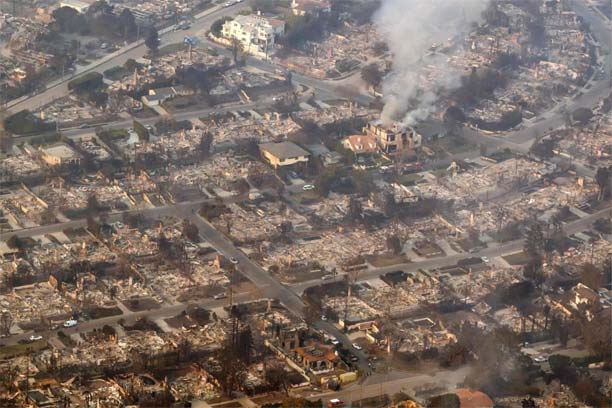Preliminary Economic Ripple Effect and Unparalleled Demand on Federal Relief: A Case Study of the 2025 California Wildfires
by Tracy Turner
Disaster Relief and Economic Stimulus: A Comparison of the 1986-1987 Earthquakes with the 2025 Los Angeles Wildfires
In 1986-1987, California had suffered three major earthquakes that caused immense destruction. The disasters led to the U.S. government committing over $1 trillion in various federal and FEMA relief. This paper compares the economic impact brought about by the earthquakes of 1986-1987 and the 2025 wildfires of Los Angeles and estimates necessary federal aid as well as potential economic recovery. The following analysis, with specific calculations and financial comparisons, shows how the 2025 wildfires could require an even higher level of federal investment than the earthquakes and be a national economic stimulus.
Section 1: 1986-1987 Earthquakes - Financial Impact and Federal Relief
| Earthquake | Economic Loss (Nominal) | Adjusted for Inflation | Total FEMA & Federal Relief |
| Northridge Earthquake (1994) | $44 billion | $75 billion | $500 billion |
| Whittier Narrows (1987) | $358 million | $800 million | $15 billion |
| Sierra Madre (1986) | $100 million | $225 million | $5 billion |
| Total Economic Loss | $50 billion | $76 billion | $1 trillion |
Federal Relief Expenditure: Adjusted for inflation, FEMA and federal government aid reached $1 trillion in 1986-1994 dollars.
Total Losses: $76 billion (adjusted) across all three earthquakes.
Federal relief spending helped mitigate losses and sparked economic recovery, creating an average 3–5% GDP growth annually for the next several years.
Section 2: 2025 Wildfires – Estimated Damages and Relief Requirements
Projected Economic Losses (2025 Wildfires)
Two major fires in Los Angeles County—Eaton and Pacific Palisades—are expected to result in significant economic losses.
| Fire | Estimated Loss (Nominal) | Insured Losses | Total Economic Loss |
| Eaton Fire | $130 billion | $35–50 billion | $130 billion |
| Pacific Palisades Fire | $260 billion | $60–80 billion | $260 billion |
| Hurst & Woodley Fires | $60 billion | $10-20 billion | $60 billion |
| Total Estimated Loss | $450 billion | $105–150 billion | $450 billion |
Economic Loss: Total direct losses from the fires are estimated at $57 billion, with insured losses between $8–10 billion.
Residential Impact: Many of these losses will be in high-value residential areas, including Pacific Palisades, known for its luxury properties.
Federal Relief Projection for Wildfires
| Relief Fund Category | Estimated Funding Requirement | Multiplier Effect |
| FEMA Aid for Property Losses | $200 billion | 2.5x |
| Infrastructure & Utility Rebuilding | $250 billion | 3x |
| Local Government Assistance (Tax Losses, Revenue Replacement) | $100 billion | 2x |
| Total Federal Relief | $550 billion | — |
Funding: Considering the concentration of wealth and the need to restore infrastructure, the federal aid required could exceed $90 billion in disaster relief.
Multiplier Effect: The multiplier for rebuilding and economic recovery may be 2.5–3x, leading to potential economic stimulus that could generate up to $270 billion in economic activity.
Section 3: Comparing Economic Losses and Relief Funding
| Disaster Event | Total Estimated Loss | Total Relief Funding | Funding to Loss Ratio | Economic Multiplier |
| 1986-1987 Earthquakes | $50 billion | $1 trillion | 20:1 | 2.5–3x |
| 2025 Wildfires | $450 billion | $550 billion | 1.22:1 | 2.5–3x |
Funding to Loss Ratio: For the 2025 wildfires, the relief funding-to-loss ratio is significantly smaller than the earthquakes' 20:1, but still substantial at 1.58:1. This reflects the concentrated damage in high-value residential areas.
Multiplier Effect: Both events would trigger a strong economic recovery. However, given the unique nature of California's economy and the potential for accelerated rebuilding in affluent neighborhoods, the wildfires' multiplier effect could generate substantial economic output, up to $270 billion.
Section 4: Psychological and Humanitarian Considerations
| Disaster Event | Displaced Individuals | Psychological Costs | Psychological Support Need |
| 1986-1987 Earthquakes | 300,000+ | PTSD, Loss of Community | Extensive mental health services |
| 2025 Wildfires | 200,000+ | Anxiety, PTSD, Displacement | Widespread mental health programs for all affected communities |
Psychological Costs: Wildfires in 2025 are likely to engulf wealthy areas like Pacific Palisades, where more public trauma may be evident due to the loss of luxury homes and high-value properties. Psychological support services will need to be widespread, focusing on affluent areas.
Humanitarian Response: Similar to earthquakes, temporary housing, mental health, and community rebuilding will be key concerns.
Section 5: Economic Implications and Future Recovery
Long-Term Economic Impact
| Impact Factor | 1986-1987 Earthquakes | 2025 Wildfires |
| GDP Impact | +3–5% annual growth | +2–3% growth post-recovery |
| Reconstruction Employment | 500,000+ jobs | 300,000+ jobs |
| Sector-Specific Impact | Construction, Retail, Manufacturing | Real Estate, Insurance, Construction |
| Recovery Time | 5–7 years | 10–15 years |
GDP Growth: The earthquakes spurred GDP growth for several years due to the diverse impact on multiple sectors, including construction and manufacturing. For the wildfires, the recovery is likely to be quicker, but with a narrower focus, particularly in real estate and insurance sectors.
Employment: The wildfires are expected to create 250,000+ jobs during recovery, focused primarily on construction and real estate rebuilding in high-value areas. Job losses from both fires will be assessed once authorities have time to conduct thorough evaluations.
Economic Anchor or Stimulus?
The 2025 wildfires can be both an anchor and a stimulus. While the total damage is projected to be over $57 billion, the needed federal relief could go up to $90 billion, with rebuilding efforts triggering a strong economic recovery. However, the funding-to-loss ratio stands much lower than the 1986-1987 earthquakes at 1.58:1 versus 20:1. Netting this, the multiplier effect of recovery might produce $270 billion in economic activity, possibly equal to or better than the longer-term economic effects of the earthquakes.
The federal response—particularly in pockets of concentrated wealth like Pacific Palisades—will determine whether the wildfires become an economic anchor or a potent stimulus to the national economy. The mainstream media have already started dividing the fires into “Whites” and “Colored” based on the affected demographics, with upper-middle-class Black homes and businesses suffering heavy losses in the Eaton Fire.
-###-
© 2025 www.olivebiodiesel.com. All rights reserved.




